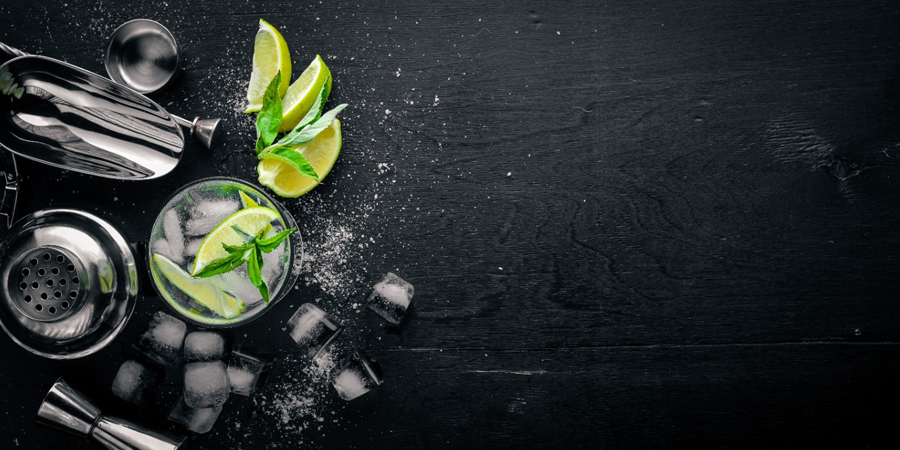With Climate Change becoming an increasing concern for many, the search for new ways to reduce the impact on the environment is receiving growing attention from all industries. The Spirits Industry has already been a leader in some aspects of this field, from recycling wastewater in distilleries to bartenders finding creative uses for discarded garnishes. Even some of the fundamentals such as glass spirits bottles and earth-friendly farming of ingredients are being examined.
In this article, we will examine:
How is Gin made, and what’s the impact?
The principle of distilling is simple. Add some yeast to sugary ingredients to convert those sugars into alcohol, then add water. Heat the resulting solution until the alcohol vapourises and separates, then cool it back down into a liquid elsewhere. Given the scale of most commercial distilling operations though, this ends up using quite a large amount of electricity, water and raw ingredients. Furthermore, most ingredients need to be processed first to ensure quality fermentation. This can generate quite a carbon footprint
The good news is that a great number of distilleries are able to reuse or recycle in clever ways. Wastewater can be treated and reused. Raw ingredients are turned into animal feed. One particularly interesting example is waste heat energy being used to warm up a local swimming pool. The bigger distilleries have installed bio-digestion plants to reduce their impact on the power grid, the biggest can even capture CO2 (a co-product of fermentation) to make carbonated drinks.
Despite these efforts, there are three big failings in the environmental approach: the packaging; the transport; and the production & supply of the ingredients. Unfortunately transporting finished spirits remains a problem still to be solved, but let’s look at what some producers are doing to mitigate other areas.
Packaging
Packaging has seen some innovation as producers look at sustainability more creatively. Diageo has rolled out bottles made from recycled paper for the top-selling Scotch whisky in the world, Johnnie Walker. Sustainable and easily recyclable, Diageo claim this reduces the typical carbon footprint on spirits bottle production by 75%! A small number of gin distilleries have supported this such as Silent Pool and North Berwick (NB) Gin.
Another big change in packaging is the ecoSPIRITS closed-loop distribution system. Designed to work hand-in-hand with distributors and venues, this works by providing large-format containers that are collected and refilled like beer kegs. These containers are secure for transport and for long-term storage. Much larger airtight containers will be provided by producers to the distributors, effectively eliminating potentially millions of individual glass bottles from the supply chain. This was pioneered through Proof & Co in Singapore but has been rolled out in an increasing number of international markets. The technology has also been licensed by some of the global players, with Pernod Ricard signing a recent deal for their premium spirits brands to be distributed in this way. While ecoSPIRITS is not suitable for the home consumer or smaller venues, most of the impact on the environment comes from the bar and restaurant business anyway so is a very important step in the right direction for true sustainability.
Ingredients
What about the ingredients? Every spirit is different, but previously they have been derived from either sugar cane, fruit, cereals or their by-products. This is, of course, a key part of what makes a spirit fit into a particular category. For example, fruit is required to make brandies but whiskies are defined by using different grains. Gin is more complicated, however. To get the starting base alcohol, gin distillers are permitted to use any starting ingredients. The magic comes in the mix of botanicals. At the very minimum, gin needs a source of juniper on top of the base, but almost all gins use a few more – some a lot more! With very few countries able to grow everything required for even the most basic London Dry style Gin, this category moves into unsustainability very quickly. For example, a fair amount of the world’s best-selling gin comes from the UK, with orange and lemon peel being two of the most commonly used botanicals. However Britain’s cold climate is not exactly famed for its citrus production. It’s becoming trendy for small-scale boutique distilleries to draw inspiration from their terroir, taking inspiration from local horticulture to inform what they make. But even with the best of intentions, should that distillery achieve larger scale success, they may have to resort to the world market for sourcing ingredients.
Arbikie Distillery in Lunan Bay
Luckily a way forward has been found at the Arbikie Distillery in Lunan Bay, Scotland. Their Nadar Gin (Gaelic for Nature) is made literally unlike any other gin, thanks to two key elements. One way in which they have innovated is in their large-scale investment in greenhouses and polytunnels where they can simulate warmer conditions to suit their botanical needs. Growing their own juniper as well as more unusual ingredients for Scotland such as lemongrass and makrut lime leaf cuts thousands of air miles off their total carbon footprint.
Give Peas a Chance
The other innovation which is truly unique is their raw ingredient – Garden Peas. Kirsty Black, Head Distiller at Arbikie, has pioneered a process of using this humble legume as a viable source for high-quality spirits production. Garden peas do not require Nitrogen fertilisers which can be environmentally damaging. They also help regenerate the soil, removing the need for crop rotation and restorative fertilisers. Lastly, every element of production not used directly in distillation can be used for animal feed, eliminating wastage completely. Even better, the resulting gin tastes great with an earthy and spicy character that goes well in a Martini or Red Snapper. They also produce a Vodka using the same techniques. Despite currently using glass bottles Nadar has been scientifically proven to be Climate-Positive with 1.54Kg of carbon being ‘fixed’ for every 700ml bottle produced. They are also moving in the UK joining with ecoSPIRITS to further enhance their green credentials. Surely we will see more legume spirits on the way, but Nadar will forever be the pioneer of this new way to make a good drink.
With certain innovations only coming in the past couple of years, it is clear that this is an exciting time to be looking at sustainability and climate-kind practices. Hopefully we will see more such innovations coming soon at a time when they can still make a difference. In the meantime in Singapore, you can grab a glass or two of Nadar and help the planet while you sip!
Click here to explore more Gins










